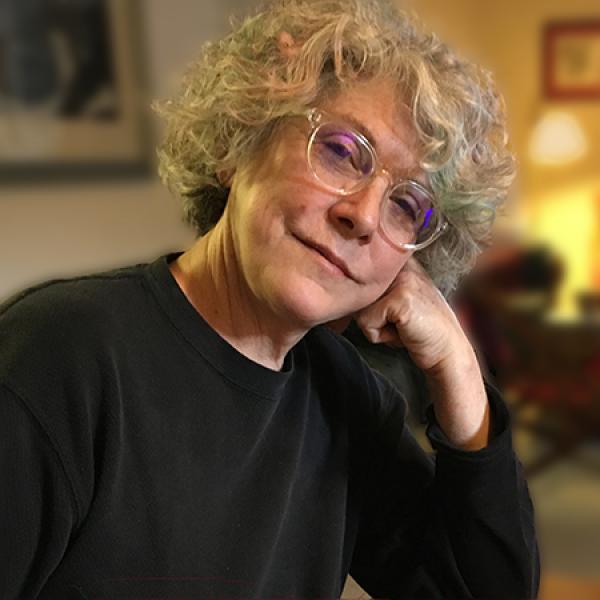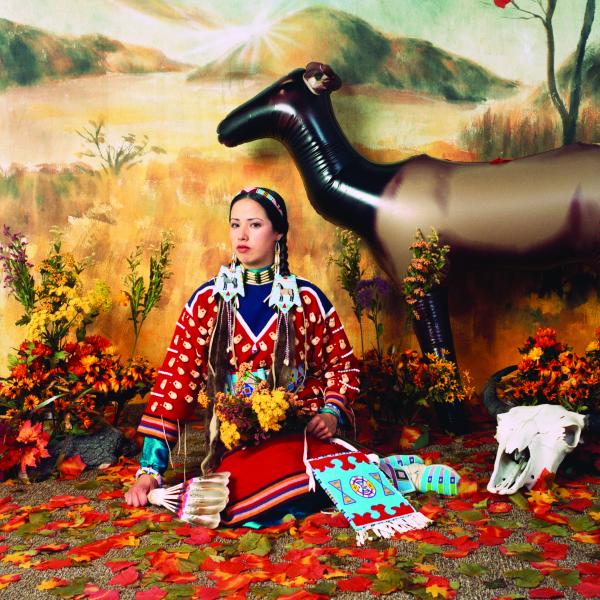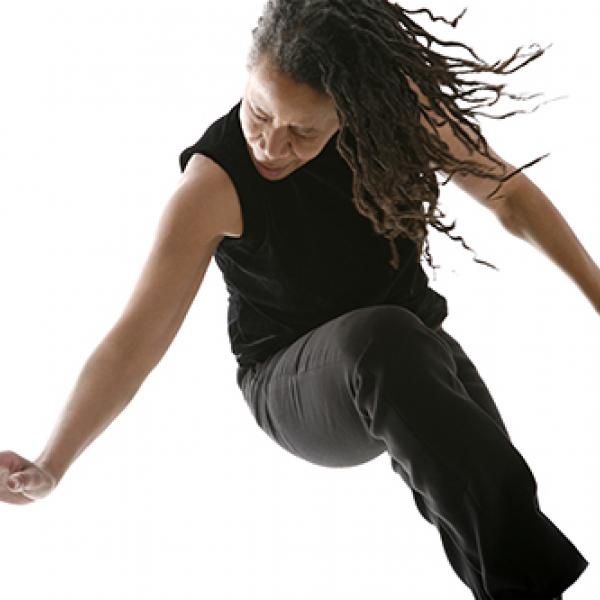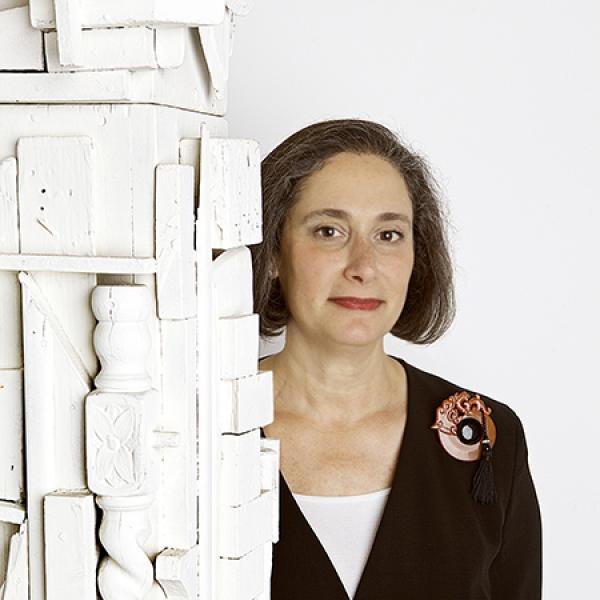Emily Pilloton: Girls Garage is a physical place; it is a 3600-square-foot place-- space in west Berkeley. It’s a workshop, it’s a maker space, it is a welding studio, it’s a screen-printing shop, and it exists because I wanted to create a space for young girls nine to seventeen years old, sometimes grown-up girls also, to come together and learn how to build things and to learn how to build things in multiple materials and media and ideally to be doing that in the service of their communities. So we teach girls hands-on skills and our goal is to put those hands-on skills towards projects that can live outside of the walls of Girls Garage in a homeless shelter or a women’s center or a public school, out in the world where they have an impact beyond just our time together at Girls Garage.
Jo Reed: Designer, builder and educator Emily Pilloton has always learned best by doing and knew she was hardly unique in this. After graduating from Architecture School, she found she missed the process of creating a design and then physically implementing it. She missed getting her hands dirty. And she wanted to do work that connected to her community. So Emily did something about it. In 2008 she began Project H Design a not-for-profit that connects design with community. Two years later, she moved the idea into the classroom with Studio H, a high-school design and build program. It was and is very successful with high school kids guiding a project every step of the way from idea to planning to building to seeing it live in their community. But Emily Pilloton also began to notice something: Boys and girls were experiencing Studio H very differently.
Emily Pilloton: I found that my girls were often stepping back from certain opportunities. If I asked someone to cut 12 pieces on the chop saw, even though I knew they were highly capable sometimes they wouldn’t volunteer to do it or they would defer something to some of the male students. And I knew that that wasn’t because of ability; it was because of a dynamic that existed in doing that type of work. And so I began to pull out small groups of girls just to work with them as small groups of girls and see how that dynamic changed and it was like night and day; it was incredible. They were voicing their opinion, they were doing things that were brave and scary and operating chop saws and chain saws and welders and it was-- it just felt so different and so I wanted to expand upon that and to be intentional about creating a space just for girls so that there wasn’t that sense of caution or self-doubt and that is something I have experienced myself. And so the minute we created Girls Garage there’s this question about well, are girls even interested, are there girls that will sign up for this type of thing, and not only was there so much interest but that the very first season we had a wait list; there were so many girls who were really hungry for this type of activity of hands-on building and learning and that they were really drawn to a space that was with other girls and was led by female instructors who were highly skilled in these areas.
Jo Reed: You’ve talked a little bit about the space of Girls Garage itself but tell me some of the equipment that you have in there.
Emily Pilloton: We have a large downstairs kind of open-plan wood shop and more open maker space and a little corner where we do welding and then upstairs we have a more traditional classroom set up with a projector and we have some laptops and some movable tables that we can do group work at, but in terms of equipment I definitely usually fall on the low-tech side of things. We do have a laser cutter, we have a 3-D printer, we have a vinyl cutter, but for the most part we pretty much use hand and some power tools I’d say 90 percent of the time. So we have a full array of drills, drivers, hand tools, chisels, hammers, mallets, a scroll saw, a band saw, a chop saw, a drill press, a MIG welder, screen-printing equipment, lock-picking kits. So I think definitely our equipment falls more on the hand-based side and the high-tech things we sort of add in as supplementary or enhancements to something that’s handmade.
Jo Reed: When they design they tend to do it by hand.
Emily Pilloton: Yeah. Maybe this is something where I need to grow a little bit myself but I went to UC Berkeley and studied architecture from 1999 to 2003; we did everything by hand. We drafted by hand; we built models by hand. I don’t even know that they allowed digital drawings; I never made one. So I think because of that I’m very grateful that I learned how to do those things by hand and so I guess I think about it like it’s easy to learn digital skills on your own especially for a generation that is so naturally inclined now to digital learning and screen-based instruction. I think actually it’s more important in Girls Garage to learn the hand-based skills so I do think that’s a skill that they probably won’t learn anywhere else so I want to be that place.
Jo Reed: Tell me about the girls who come to the program. Who are they typically?
Emily Pilloton: The girls that come to the Girls Garage are really-- they’re from all over. They have really different backgrounds which-- there are a lot of programs that are very explicitly targeted to girls who come from under-resourced communities, mostly girls of color, and we do-- I would say we actually have a really-- a truly diverse mix of girls. We have girls who come from very privileged families and we have girls that were living in homeless shelters and I think that that’s actually really special that we come together and the act of building is this equalizer of sorts, that we all have the same experience together and that the stories that we bring are part of what makes that work so special. So I would say we have a really good socioeconomic mix, a very diverse racial mix, the way girls identify with being a girl. There are definitely girls who have more sort of evolving definitions of their own gender and that’s also a really special conversation to be having with them at this time in their life. Most of them geographically come from the Bay Area, and then over the summer we actually have girls who fly in from other parts of the country and stay with family or sometimes we find them host families so we’ve had girls from Baltimore, from upstate Washington, from Mississippi, and that feels really special too that we get to have a really diverse group of girls who want to do something with other girls that’s really special that they don’t have access to in their home communities.
Jo Reed: What do the girls build?
Emily Pilloton: So the girls build a lot of different things. We have a couple different classes that focus on a specific medium and then over the summer we have these intensive week-long sessions that combine a lot of the different media. So for example in our afterschool classes we have one day per week that’s dedicated to one topic so Tuesdays is always welding, Thursdays is always woodworking and carpentry, Wednesdays is more graphic design and print-based entrepreneurship, making products to sell, and Mondays is an advanced design build for teen girls, which is more engineering and architecture. So we think about it sort of in topical tracts like that and then the things that they build fall into one of two categories. One is when they walk in the door and they’re nine years old often we do a project that’s really just about skill building and something that they can take home so we’ve made toolboxes; we’ve made gumball machines; we’ve made wooden spoons; we’ve made wooden robots. These are just things that build manual dexterity and familiarity and vocabulary for the tools. The culmination of all that work though happens over the summer where we build real projects for real clients so last summer for example we built a fruit stand for a group called Refugee Transitions that works with refugee youth and families. We built one four bookshelves and two toy chests for the women’s shelter that is about a mile away from us. We’ve built planter boxes for schools; we’ve built <laughs> little cat and dog toys for the animal shelter; we’ve built a greenhouse. So we do smaller projects and we take them home but the ultimate goal is to be building things that are for a specific client that live in the world that the girls have the ability to design and deliver and that live on in the world in service of someone else.
Jo Reed: The girls work together; it’s a collaboration.
Emily Pilloton: They do. We structure our classes in certain ways. Sometimes they’re working in a group of four and their project is the bookshelf for example. Other times, let’s say we have a group of 24 girls over the summer. Sometimes we’ll do a giant project that we can break up into 24 small parts sort of like a modular approach so we did a gigantic bookshelf where each girl was responsible for one module and then we put all the modules together into this massive bookshelf. So there’s different ways that we design the project in terms of workflow and that’s always a fun challenge, how do you get 24 girls to each feel invested in this larger thing without it losing the quality required to build a giant bookshelf. So that’s-- we’ve taken a number of different approaches in terms of group work but they’re always working together in some way.
Jo Reed: It’s not just giving girls skills, which Lord knows is a fabulous thing; it’s actually changing the way they think about themselves.
Emily Pilloton: Yeah, that’s been the most incredible thing to witness. I mean I loved teaching high school in my coed classroom and building things with high-school kids but there is something so immediate it. I will have a girl walk in the door looking one way and then over the course of an hour and a half she learns how to weld and she walks out the door looking completely different like “I just fused metal. Don’t you dare tell me I can’t do anything.” And it’s really tangible and I love that the simple act of getting to use a tool you haven’t used or doing something that you thought was impossible that those are so immediately transformative for girls, and as an instructor to be able to witness that--it’s incredible.
Jo Reed: How did you figure out that experiential learning, actually building, getting dirt under your fingernails could be so transformative for young people, for boys but also especially for girls?
Emily Pilloton: This is just how I always learned and I learned how to do stuff as a kid. I was more interested in learning how to do stuff than learning stuff from a book. I wanted to know “how,” not-- I didn’t want to know “that.” And so I have two younger sisters. I spent so much time with the two of them “putzing” around in the backyard, in the forest cutting down small trees and digging holes, and I think I’ve always just found that thinking through my hands is the way that I make sense of the world and I don’t think I’m alone in that. I think a lot of people learn that way and yet the way that schools are set up are often not structured to cultivate that type of learning. And so knowing that about myself and then growing up and going to high school and college I was very cognizant that that was something that was really special to me and I wasn’t willing to let that go. And so then when I entered my professional career and was working in architecture and design that sort of disappeared and I was frustrated; I was frustrated that I didn’t have more opportunities to learn through my hands. And so Project H and Girls Garage grew a lot out of that disconnect, out of that frustration that as a professional grownup, as an adult, I had really lost the ability to access that type of learning and wanted to keep that alive selfishly for myself and also for young people who I know many of whom, boys and girls, need that type of learning; that’s how they connect their brains to something real.
Jo Reed: Yeah… even architecture, which is probably the closest marriage of art design and technical know-how and engineering, etc., but it’s not like the architects are out there actually building.
Emily Pilloton: Right. So this is the most frustrating thing for me. When I was in high school I fell in love with architecture thinking that it was that, that it was this person sketching something on a napkin, figuring out mathematically how it stood up and then going out and digging the foundation and doing it, and that is not the way the industry works, and-- unless you’re sort of a rogue design builder and I found that to be disheartening when I figured that out, that as a recent graduate from a graduate program in architecture and design that I didn’t get to do that stuff. I was like “Wait a second. This isn’t what I signed up for.” So I don’t blame the field of architecture for that but I do think that there are a lot of people that come to architecture wanting that type of-- a type of hands-on, deeply complex learning and you don’t end up getting to do that unless you really carve out a niche for yourself. And so that’s what I tried to do with Project H and wanting to make that available to many other people.
Jo Reed: How many girls have passed through Girls Garage?
Emily Pilloton: Since 2013, about-- just under four hundred girls have come through Girls Garage and of that four hundred over two-thirds, so two-thirds of four hundred, have been repeat participants so that means-- and actually I should say that of the two-thirds probably half have been there since the beginning for five years straight. So they just keep coming back and I think a lot of them-- four hundred’s not that big of a number and I don’t think we’ll ever be like “Oh, a million girls” but I care more deeply about the girls wanting to come back and seeing a pathway and staying with us for multiple years where they can see their own growth and where we can see their growth.
Jo Reed: In the past five years since Girls Garage began, what have you learned about girls and learning and learning with your hands?
Emily Pilloton: Oh, yeah. <laughs> I guess the best answer to that is that I now have girls who I’ve had for five years. They came to me as like little babies and now they are getting their driver’s licenses, and what they have taught me is that every single time I’ve given them a challenge thinking well, I-- we’ll see how this goes, I don’t know if they’re going to figure it out, it’s very difficult, every single time they kill it. So I think the thing that I’ve learned is that there is no challenge too great and that I as the leader have a responsibility to expand my own expectations constantly to be continually pushing what my line is of what I expect and what I think is possible because the further I push that line the further they’re able to so I think that’s one thing I’ve learned. I’ve learned to listen. I think I’ve always been a relatively good listener but because I’m a leader I also feel like I have to take the lead and I have to be the first person to speak and tell people what to do and let me show you how to do this thing, and I think I’ve learned that it’s also okay to sit back and let them do it and they always rise to the challenge. So that’s been really fun for me too to be a little bit more-- “passive” is the wrong word but more of a listener and an observer and to really let the girls drive.
Jo Reed: What’s the Girls Garage motto?
Emily Pilloton: Our motto is “Fear less, build more,” and the history of this motto is that two years ago we did a rebrand with this awesome design firm in Chicago called Firebelly and one of the things that they pushed us to create was stronger messaging and storytelling. And the idea for that motto came out of conversations we had with them around the idea of fear and that we’re all scared of something. The goal is not to be fearless-- I think people that are without fear that-- have some-- maybe some problems <laughs> it seems like—
Jo Reed: I think they call that a “psychopath.”
Emily Pilloton: Yeah, or a sociopath, yeah. We have fear for a reason and so what I want to encourage in my girls is not to be fearless all the time but to act in the face of fear and to learn how to be brave even when you are and especially when you are scared. And so we talk a lot about bravery and that bravery is something you can practice and one of the ways to practice that is by building things and picking up a tool you haven’t used or working with someone you haven’t worked with before or saying “yes” to a project that you’ve never done. And so we try to just cultivate that environment that this is a safe space to be afraid and to build something in the face of that fear.
Jo Reed: This is a big question: When you think about this next generation of girls coming through and coming through your program what is it that you want for them, that you want them to have if they get all ten badges for example?
Emily Pilloton: Yeah. I mean there’s so many data points that I think people expect us to be pointing to to define our success. For example, I want more girls going into the STEM pipeline; I want more girls of color interested in engineering. These are all the things that we sort of know those are the metrics so I do-- those are my goals for sure but I also think that-- I mean any time you work with kids I think the success metrics are not even observable for a decade or two or three. We’re playing the long game and we’re not in the business of short-term returns when we work with kids and so-- I don’t know. To me I think about 20 years from now I want one of my girls to call me and tell me about how they have this awesome job or they started their own business or something happened in the workplace and they stood up for themselves. I think those qualitative things are so much more important to me and unfortunately that’s not a data point. So I think the biggest success metrics for me are about voice, are about bravery and whether you end up in STEM or not that you feel like you can do whatever you want and go as far as you want to and can in that pathway. And that sounds like such a simple thing but I do-- I think that girls should never be self-limiting and I hope that Girls Garage is a small step to have them experience a taste of that, that there are no limits.
Jo Reed: That is Emily Pilloton--the founder and executive director of Project H design and Girls Garage. You can find out more at Girls Garage.org. You’ve been listening to NEA Arts Online. I’m Josephine Reed. Thanks for listening.
Music Credit:
Excerpt from “Foreric: Piano Study,” written and performed by Todd Barton from the cd
Metascapes; used courtesy of Valley Productions.











